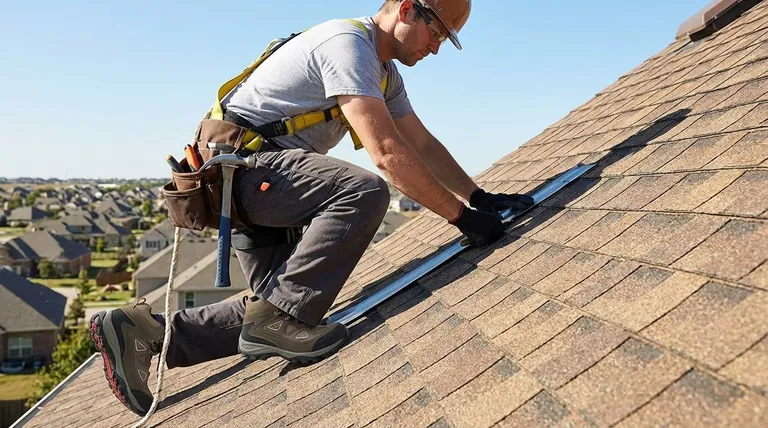The most critical features for a roofer's work boots are a high-traction, flexible sole combined with robust ankle support. These elements are not just for comfort; they are essential safety tools for navigating steep and often hazardous inclines where grip and stability are paramount. A roofer's boot must function as a specialized piece of equipment designed for a unique and demanding environment.
Your work boot is the primary point of contact between you and a dangerous surface. For a roofer, this means prioritizing grip, flexibility, and ankle stability above all other features to ensure maximum safety and performance.

Core Features for Rooftop Safety
The demands placed on a roofer's boot are unique. Unlike footwear for flat-ground construction, every feature must be optimized for traction and stability on angled surfaces.
The Outsole: Your Connection to the Roof
The single most important component is the outsole. It must provide a reliable grip on materials like asphalt shingles, tile, or metal, which can be slippery and are always at an angle.
Look for a soft rubber compound that maximizes surface contact and friction. A harder, more durable sole found on a standard work boot will not grip a sloped roof as effectively.
A slight heel is also beneficial. While it may seem minor, a defined heel is crucial for locking your footing securely onto ladder rungs during ascent and descent.
Support and Comfort for All-Day Stability
Roofing involves long hours of standing, kneeling, and maneuvering in awkward positions. Proper support is essential to reduce fatigue and prevent injury.
Ankle support is non-negotiable. A boot with an 8-inch height, for example, helps lock the heel in place and provides stability when walking on uneven or pitched surfaces.
A well-cushioned footbed absorbs impact and distributes weight, preventing the foot pain and strain that can become a dangerous distraction when your focus needs to be on safety.
Construction: Balancing Durability and Agility
A roofer's boot must be tough enough to withstand abrasive roofing materials without being so rigid that it impairs your ability to feel the surface beneath your feet.
The bond between the boot's upper and the outsole must be exceptionally strong to prevent delamination. Look for high-quality materials, like leather or durable synthetics, and sturdy construction in laces and eyelets.
Understanding the Trade-offs
Choosing the perfect boot involves balancing competing needs. Understanding these trade-offs is key to making an informed decision.
Grip vs. Outsole Durability
The soft rubber soles that provide the best grip on steep roofs will inevitably wear down faster than harder compounds, especially on abrasive surfaces like asphalt shingles. Roofers must accept that their boots are a consumable safety item that may need more frequent replacement.
Protection vs. Flexibility
While toe protection is a standard safety requirement, a heavy steel toe can reduce the boot's flexibility. This can make it harder to bend your foot and feel the roof surface, which is critical for maintaining balance. Consider lighter composite toes if they meet your site's safety standards.
Weather-Specific Features
Insulation and waterproofing are vital in certain climates but add weight and reduce breathability. For work in hot weather, these features can lead to significant discomfort. Choose boots with environmental protection only if your typical working conditions demand it.
Making the Right Choice for Your Goal
Select your boot based on the specific demands of your work environment.
- If your primary focus is safety on steep pitches: Prioritize a boot with the softest, highest-traction sole you can find, combined with excellent ankle support.
- If your primary focus is working on abrasive asphalt shingles: Choose a boot known for its durable upper construction and strong outsole bonding, accepting that the sole itself will wear down over time.
- If your primary focus is working in cold or wet climates: Select an insulated and waterproof model, but ensure it doesn't compromise the critical need for flexibility and grip.
Ultimately, the right work boot is a crucial tool that directly impacts your safety and ability to perform your job effectively.
Summary Table:
| Key Feature | Why It's Critical for Roofers | What to Look For |
|---|---|---|
| High-Traction Outsole | Provides grip on slippery, angled surfaces like shingles and metal. | Soft rubber compound, defined heel for ladder rungs. |
| Ankle Support | Ensures stability and prevents injury on uneven, pitched surfaces. | 8-inch boot height, secure fit to lock the heel. |
| Durable & Flexible Construction | Withstands abrasive materials while allowing agility to feel the roof. | Quality leather/synthetics, strong sole bonding. |
| Comfortable Footbed | Reduces fatigue during long hours of standing and kneeling. | Well-cushioned insole for impact absorption. |
Ready to equip your team with the safest, most reliable work boots?
As a large-scale manufacturer, 3515 produces a comprehensive range of high-performance footwear designed specifically for the demands of professional roofers. We offer durable boots with superior grip and ankle support to enhance on-the-job safety and performance for distributors, brand owners, and bulk clients.
Contact us today to discuss your specific needs and discover how our production capabilities can deliver the perfect boot for your goals.
Visual Guide

Related Products
- Safety Footwear Wholesale Manufacturer for Custom OEM/ODM Production
- High Performance Fire-Retardant Waterproof Safety Boots
- Premium Wholesale Waterproof Safety Boots High Performance Protection for Industrial Markets
- Premium High-Cut Waterproof Safety Boots Manufacturing & Wholesale Solutions
- Heavy-Duty Waterproof Nubuck Safety Boots Safety Shoes for Bulk Supply
People Also Ask
- What do heavy duty boots do? Protect Your Feet in Demanding Work Environments
- How long can you wear safety boots? The Lifespan is Determined by Wear, Not Time
- Is safety-toe as good as steel toe? Choose the Right Protection for Your Job
- What are the cultural perspectives on wearing shoes in the house? A Guide to Home Etiquette & Hygiene
- What are OSHA approved shoes? Understanding the Correct Standards for Workplace Safety



















